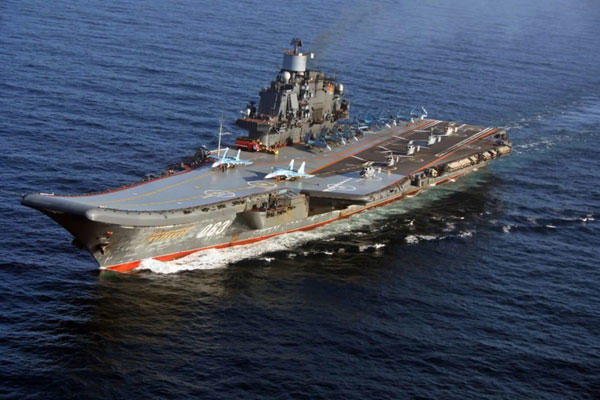Russia planned to send its only aircraft carrier on a port visit to Syria later this year in a sign of Moscow's long-term commitment to the regime of President Bashar al-Assad despite threatened missile strikes by the U.S.
More immediately, Russian defense officials were quoted Wednesday as saying that the Russian guided-missile cruiser Moskva had arrived at the Straits of Gibraltar enroute to the eastern Mediterranean.
The 611-foot Moskva, carrying "Sandbox" anti-ship missiles and "Favorit" surface-to-air missiles, "will take over as the flagship of the (Russian) naval task force" in the region that also includes a destroyer and a frigate, a Russian Defense Ministry official said, according to the Russian Interfax news agency.
On Sunday, Russian officials said that the intelligence and reconnaissance ship Priazovye was being sent from the Black Sea to the eastern Mediterranean and would operate separately from the naval task force.
The buildup of Russian naval forces in the region, where four U.S. guided-missile destroyers are on station for possible strikes against Syria, posed little threat to the U.S. Navy, Gen. Martin Dempsey, chairman of the Joint Chiefs of Staff, said Wednesday.
Without referring specifically to the Russian task force, Dempsey told a hearing of the House Foreign Relations Committee on the Syrian crisis that it was his judgment that "there are no capabilities that can threaten them" – given the self-defense measures aboard the U.S. ships and other U.S. military assets in the area.
On the general possibility of retaliation for U.S. strikes by Syria or others, Dempsey said "we're as prepared as we possibly could be."
The 890-foot Kuznetsov, with more than 2,000 Russian sailors aboard, does not have catapults for launching aircraft and instead has a ski-jump ramp on the bow to assist the 20 Sukhoi Su-33 "Flanker" fighters aboard in getting airborne.
"At the end of the year, most likely in early December, the Project 11435 heavy aircraft-carrying cruiser the Admiral Kuznetsov will set off on a long-distance sea voyage during which it will call at the Russian Federation Navy's Logistical Support Center in the Syrian city of Tartus," the official Russian newspaper Rossiyskaya Gazeta reported, citing a Russian Defense Ministry official.
The Kuznetsov's port visit to Tartus was not connected to the Syrian civil war or the U.S. Navy buildup, the newspaper said. Russia officially calls the Kuznetsov a "cruiser" to get around international maritime laws that bar aircraft carriers from passing through the Dardanelles to the Black Sea.
Since it was launched in 1985, the Kuznetsov has spent little time at sea and has mostly been dockside for lack of funding or in repair yards for refitting.
The Russian naval presence in the eastern Mediterranean amounted to a "standard harassment package" for the U.S. Navy, similar to events in the Cold War when the Russian and U.S. fleets would shadow each other's movements, said retired Navy Cmdr. Chris Harmer.
The Russian ships "have no ability and no interest" in confronting the U.S. Navy, but "they can give a lead time and an update to the Syrians on the when and where of the launch" of the Tomahawk Land Attack Missiles aboard the U.S. destroyers, said Harmer, now a naval and Mideast analyst for the Institute of the Study of War.
The planned presence of the Kuznetsov later this year "was a sign of the Russian commitment" in the long term to Syria and Assad's survival, Harmer said. Tactically, the Kuznetsov has little to offer, Harmer said, but "strategically it's a visible sign of Russia's commitment to Syria."





























